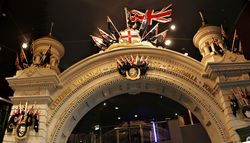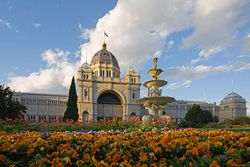اتحاد أستراليا
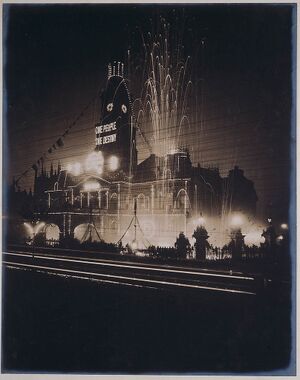
| جزء من سلسلة عن |
| تاريخ أستراليا |
|---|
 |
| زمنياً |
| قبل التاريخ |
| 1606–1787 |
| 1788–1850 |
| 1851–1900 |
| 1901–1945 |
| Since 1945 |
| خط زمني |
| حسب المواضيع |
| الاستكشاف |
| الدستور • الاتحاد |
| الاقتصادي • السكك الحديدة |
| الهجرة • السكان الأصليون |
| العسكري • الدبلوماسي |
| الولايات والأراضي والمدن |
| نيو ساوث ويلز • سيدني • نيوكاسل |
| ڤيكتوريا • ملبورن |
| كوينزلاند • بريزبين |
| أستراليا الغربية • پرث |
| جنوب أستراليا • أدليد |
| تازمانيا • هوبارت |
| منطقة العاصمة الأسترالية • كانبرا |
| الأرض الشمالية • داروين |
اتحاد أستراليا Federation of Australia كانت العملية التي شكلت بها الست المستعمرات ذاتية الحكم البريطانية المنفصلة نيو ساوث ويلز، كوينزلاند، جنوب أستراليا، تازمانيا، ڤيكتوريا وأستراليا الغربية اتحاداً فدرالياً. عندما أصبح دستور أستراليا سارياً، في 1 يناير 1901، أصبحت المستعمرات معاً ولايات كومنولث أستراليا.
جهود اقامة الاتحاد في منتصف القرن 19، أعاقها نقص التأييد الشعبي للحركة. وقد انعقدت عدة مؤتمرات أثناء عقد 1890 لكتابة دستور للكومنولث. السير هنري پاركس، الوزير الأول في نيو ساوث ويلز، كان محورياً في تلك العملية. فيجي ونيوزيلندا كانتا في الأصل جزءاً من تلك العملية، إلا أنهما قررتا ألا تنضما للاتحاد.
السير إدموند بارتون كان رئيس وزراء أستراليا لتسيير الأعمال عند الانتخابات الاتحادية في 1901 الافتتاحية، والتي كانت نتيجتها أن احتفظ بالمنصب.
The main economic manifestation of federation was an Australian customs and fiscal union.[1] Although the customs union entailed a high external tariff on imports from outside of Australia, there was the elimination of tariffs on interstate Australian trade, and the net effect of federation on welfare was positive, insofar as trade policy was concerned.[2]
This period has lent its name to an architectural style prevalent in Australia at that time, known as Federation architecture, or Federation style.
الفكرة الاتحادية
المجلس الاتحادي
- مشكلات التطور المستقل
ناقشت المؤتمرات المحلية للمستعمرات، خلال الفترة بين عامي 1863 و1880، المواضيع التي تتطلّب جهودًا متضافرة، وأضحت المشاكل الناجمة عن التطور، أمورًا ظاهرة للعيان. فمثلاً، أنشأت نيو ساوث ويلز، شبكة لخطوط السكك الحديدية، بعرض مختلف عن جيرانها. ولم يكن لدى أيّ من القادة، الاستعداد للتنازل عن المصالح الخاصة لمستعمرته لمصلحة الآخرين. وكانت المستعمرات الضعيفة تخشى القوية، وتضطرم نار الغيرة فيما بين الأقوياء. ومع هذا، كان هناك إجماع بأن بريطانيا سوف تضمن حمايتهم ضد أيِّ تهديد خارجي.
- الشعور الوطني المتزايد
ألحت أمور عديدة، خلال الفترة نفسها، على ضرورة العمل من أجل الوحدة، منها حاجة الحكومات لوقف الهجرة الصينية، واختطاف المستوطنين في جزر البحر الجنوبي للعمل في مزارع قصب السكر والقطن في كوينزلاند، إضافة للخشية من وصول عمليات التوسع الأوروبي إلى الجزر المتاخمة لأستراليا. لذا قام السير توماس ماكلريث رئيس وزراء كوينزلاند، لإحباط المخططات الألمانية في پاپوا، بضم غينيا الجديدة والفرنسية في هبريدز الجديدة. ودعا جيمس سيرفيس، رئيس وزراء فكتوريا، إلى عقد موتمر للمستوطنين، عام 1883. كما وضع السير صمويل گريفيث الوزير الأول في كوينزلاند مشروع قانون لمجلس اتحادي، أيدّته بريطانيا عام 1885. وقد شمل القانون جميع المستعمرات الأسترالية، إضافة إلى نيوزيلندا وفيجي.
- المشكلة المالية
أثّر غياب نيو ساوث ويلز على عمل المجلس الاتحادي، باعتبارها أقدم وأقوى المستعمرات، وكانت أكثر المشكلات التي تواجه الاتحاد المشكلة المالية. كان الهدف من المناقشات المالية تحقيق السياسة المناسبة لحماية التجارة وحريتها، وظلّت تلك المسألة من الأسباب الرئيسية للخلافات الدائرة بين المستعمرات.
Federal Council of Australasia
A serious movement for Federation of the colonies arose in the late 1880s, a time when there was increasing nationalism amongst Australians, the great majority of whom were native-born. The idea of being Australian began to be celebrated in songs and poems. This was fostered by improvements in transport and communications, such as the establishment of a telegraph system between the colonies in 1872. The Australian colonies were also influenced by other federations that had emerged around the world, particularly the United States and Canada.
Sir Henry Parkes, then colonial secretary of New South Wales, first proposed a Federal Council body in 1867.[3] After it was rejected by the British Secretary of State for the Colonies, the Duke of Buckingham, Parkes brought up the issue again in 1880, this time as the premier of New South Wales. At the conference, representatives from Victoria, New South Wales and South Australia considered a number of issues including federation, communication, Chinese immigration, vine diseases and uniform tariff rates. The Federation had the potential to ensure that throughout the continent, trade and interstate commerce would be unaffected by protectionism and measurement and transport would be standardised.
The final (and successful) push for a Federal Council came at an Intercolonial Convention in Sydney in November and December 1883. The trigger was the British rejection of Queensland's unilateral annexation of New Guinea and the British Government wish to see a federalised Australasia. The convention was called to debate the strategies needed to counter the activities of the German and French in New Guinea and in New Hebrides. Sir Samuel Griffith, the premier of Queensland, drafted a bill to constitute the Federal Council. The conference successfully petitioned the Imperial Parliament to enact the Federal Council of Australasia Act 1885.[4]
As a result, a Federal Council of Australasia was formed, to represent the affairs of the colonies in their relations with the South Pacific islands. New South Wales and New Zealand did not join. The self-governing colonies of Queensland, Tasmania and Victoria, as well as the Crown Colonies of Western Australia and Fiji, became involved. South Australia was briefly a member between 1888 and 1890. The Federal Council had powers to legislate directly upon certain matters, and did so to effect the mutual recognition of naturalisations by colonies, to regulate labour standards in the employment of Pacific Island labour in fisheries, and to enable a legal suit to be served outside the colony in which it was issued, "a power valuable in matters ranging from absconding debtors to divorce proceedings".[5] But the Council did not have a permanent secretariat, executive powers, or any revenue of its own. Furthermore, the absence of the powerful colony of New South Wales weakened its representative value.
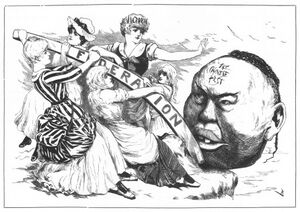
Nevertheless, it was the first major form of inter-colonial co-operation. It provided an opportunity for Federalists from around the country to meet and exchange ideas. The means by which the Council was established endorsed the continuing role that the Imperial Parliament would have in the development of Australia's constitutional structure. In terms of the Federal Council of Australia Act, the Australian drafters established a number of powers dealing with their common interests which would later be replicated in the Australian Constitution, especially section 51.
المعارضة المبكرة
وكان هناك من عارض قيام الاتحاد، حتى أواخر القرن التاسع عشر، منهم جورج ريد، الذي أصبح زعيمًا للمعارضة، والسير جون فورست، الذي عطل دخول أستراليا الغربية في الاتحاد حتى آخر لحظة ممكنة، وجوزيف كوك، وجون واطسون وأندرو فيشر، ووليم موريس هيوز.
المؤتمرات الدستورية المبكرة
In the early 1890s, two meetings established the need for federation and set the framework for this to occur. An informal meeting attended by official representatives from the Australasian colonies was held in 1890. This led to the first National Australasian Convention, meeting in Sydney in 1891. New Zealand was represented at both the conference and the Convention, although its delegates indicated that it would be unlikely to join the Federation at its foundation, but it would probably be interested in doing so at a later date.
المؤتمر الاتحادي الأسترالاسيوي 1890 (التمهيدي)
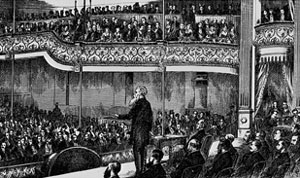
نَظَّم السير هنري پاركس المؤتمر عام 1890م، في ملبورن،[6][7] وكان ناجحًا ولقي دعمًا قويًا من الأعضاء المنتخبين، والضيوف. وحضره عدد كبير من رؤساء الحكومات، وقادة الحكومة الائتلافية في فكتوريا، ونيو ساوث ويلز وكوينزلاند وتسمانيا، وغيرها من المستعمرات التي أوفدت مندوبين عنها. وافق الحضور على إقامة حكومة للاتحاد الأسترالي على أن تكون قادرة على سنِّ القوانين وتنفيذها. وطلب المؤتمر من الحكومات المحلية، اختيار الأعضاء من الأستراليين الأصليين، وأن يتم إنجاز مشروع الدستور في ذلك الاجتماع. Carrington retorted, "Then why don't you do it? It would be a glorious finish to your life."[8] Parkes the next day wrote to the Premier of Victoria, Duncan Gillies, offering to advance the cause of Federation. Gillies's response was predictably cool, given the reluctance of Parkes to bring New South Wales into the Federal Council. In October Parkes travelled north to Brisbane and met with Griffith and Sir Thomas McIlwraith. On the return journey, he stopped just south of the colonial border, and delivered the historic Tenterfield Oration on 24 October 1889, stating that the time had come for the colonies to consider Australian federation.
Through the latter part of 1889, the premiers and governors corresponded and agreed for an informal meeting to be called. The membership was: New South Wales, Parkes (Premier) and William McMillan (Colonial Treasurer); Victoria, Duncan Gillies (Premier) and Alfred Deakin (Chief Secretary); Queensland, Sir Samuel Griffith (Leader of the Opposition) and John Murtagh Macrossan (Colonial Secretary); South Australia, Dr. John Cockburn (Premier) and Thomas Playford (Leader of the Opposition); Tasmania, Andrew Inglis Clark (Attorney-General) and Stafford Bird (Treasurer); Western Australia, Sir James George Lee Steere (Speaker); New Zealand, Captain William Russell (Colonial Secretary) and Sir John Hall.
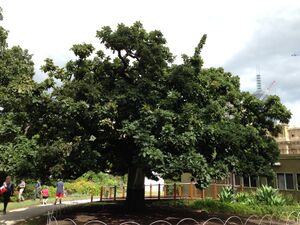
When the conference met at the Victorian Parliament in Melbourne on 6 February, the delegates were confronted with a scorching summer maximum temperature of 39.7 °C (103.5 °F) in the shade. The Conference debated whether or not the time was ripe to proceed with federation.
While some of the delegates agreed it was, the smaller states were not as enthusiastic. Thomas Playford from South Australia indicated the tariff question and lack of popular support as hurdles. Similarly, Sir James Lee Steere from Western Australia and the New Zealand delegates suggested there was little support for federation in their respective colonies.
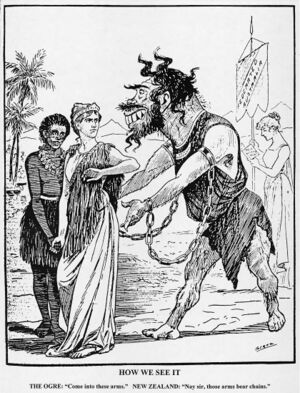
A basic question at this early assembly was how to combine federalism and responsible government. Parkes suggested the Canadian model, which federated with the British North America Act, 1867, to be similarly adopted in Australia. However, delegates from the smaller states were not enthusiastic, with John Alexander Cockburn of South Australia seeing the Canadian model as a "coercive" and "homogeneous National Union". Andrew Inglis Clark, a long-time admirer of American federal institutions, introduced the US Constitution as an example of the protection of States' rights. He presented it as an alternative to the Canadian model, arguing that Canada was "an instance of amalgamation rather than Federation."[9][10] A model closer to that of the United States was endorsed, with states able to act completely independently apart from those limited powers transferred to the federal government and where each state would be represented equally in a strong second chamber—the Senate.[11]
مسودة كلارك للدستور
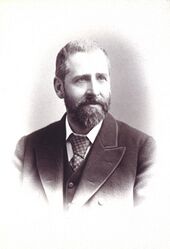
اقترح مشروع الدستور، إقامة حكومة اتحادية لرابطة الشعوب الأسترالية، تتكون من ست دول. واشتهر صمويل جريفيث بأنه أحد كبار مهندسي الاتحاد الأسترالي. وافقت الحكومات على المقررات والدستور. ولكن باقي المستعمرات، شعرت أنه لا جدوى من الاستمرار، بعد أن واجهت الآثار الكبيرة للتدهور الاقتصادي، ونالت الصعوبات المالية والخلافات الصناعية اهتمامًا أكثر من العمل للاتحاد. ومني باركيس بهزيمة في انتخابات عام 1891، وتوفي قبل أن يستعيد رئاسة الوزارة.
Clark's draft introduced the nomenclature and form which was subsequently adopted:
- The Australian Federation is described as the Commonwealth of Australia
- There are three separate and equal branches – the Parliament, the Executive, and the Judicature.
- The Legislature consists of a House of Representatives and a Senate
- It specified the separation of powers and the division of powers between the Federal and State governments.
Upon his return to Hobart in early November 1890, with the technical aid of W. O. Wise, the Tasmanian Parliamentary Draftsman, Clark completed the final form of the Draft Constitution and had a number of copies printed.[12] In February 1891, Clark circulated copies of his draft to Parkes, Barton and probably Playford as well.[13] This draft was always intended to be a private working document, and was never published.[14]
المؤتمر الأسترالاسيوي الوطني 1891
انعقد في أوائل 1891م، في سيدني، بحضور ستة وأربعين مندوبًا، عن جميع المستعمرات. ترأس الاجتماع باركس، إلا أن حالته الصحية اضطرته للتخلي عن متابعة الجلسات، وحل مكانه السير صمويل جريفيث، وشارك في وضع الدستور كلٌّ من جريفيث ممثلاً لكوينزلاند وبارتون عن نيو ساوث ويلز، وكلارك عن تسمانيا، وتشارلز كامرون كنجستون عن جنوب أستراليا. وكلهم كانوا خبراء في السياسة والقانون.
- تحول الاتحاد إلى حركة شعبية
قام إدموند بارتون عام 1893 بجولة في نيو ساوث ويلز من أجل الاتحاد. وطلب من الناخبين دعم قضية الاتحاد، وبدأت الجماعات الاتحادية بالظهور، وقد حظيت بدعم بارتون المتحمس. وكذلك، فازت حركة مماثلة في فكتوريا بدعم كبير من العمال والحرفيين، عرفت باسم منظمة الأستراليين الأصليين Australian Natives Association. وقد هيأ نجاح تلك الحملات المتوازية، الجو الملائم للدعوة إلى مؤتمر عام 1893م، وعقد جلساته في كورووا Corowa على الحدود بين فكتوريا ونيو ساوث ويلز، ومؤتمر مماثل في باثهرست.
- مؤتمر كورووا
قدم مقترحاته المحامي جون كويك، واقترح عقد اتفاقية جديدة، وأن يتم انتخاب أعضاء المؤتمر من الشعب وضرورة إجراء استفتاء شعبي على الدستور. تم التوصل في المؤتمر إلى اتفاقية عام 1895م التي دعت إلى إجراء انتخابات لممثلي المستعمرات.
المؤتمرات الدستورية اللاحقة
المؤتمر الوطني العام لعام 1897- 1898م. أعاد المؤتمر صياغة الدستور، وطرحه للاستفتاء في أربع مستعمرات. ولم تشترك فيه أستراليا الغربية أو كوينزلاند، وأيدته الغالبية العظمى في غيرهما، وساهمت جميع المستوطنات في الاستفتاء الثاني عام 1899م، الذي حصل على تأييد الأغلبية. وأُعِدَّت المستعمرات، لتكون دولاً في نظام اتحادي مكون من خمسة أجزاء، على أن يعامل كافة أعضاء المجلس الاتحادي على قدم المساواة، ويمثل مجلس الشيوخ كافة الدول بالتساوي، ويرأس السلطة التنفيذية رئيس للوزراء يختار من حزب الأغلبية، وشُكِّلت محكمة عليا لتفسير الدستور. ويمثل الحاكم العام السلطات البريطانية. ويتم تحديد علم للدولة الاتحادية. وحظيت تلك المقترحات بتأييد الحكومة البريطانية.
| الاستفتاء | NSW | Qld | SA | Tas | Vic | WA | الإجمالي | |
|---|---|---|---|---|---|---|---|---|
| 1898 | نعم | 71,595 | 35,800 | 11,797 | 100,520 | 219,712 | ||
| لا | 66,228 | 17,320 | 2,716 | 22,099 | 108,363 | |||
| 1899 | نعم | 107,420 | 38,488 | 65,900 | 13,437 | 152,653 | 377,898 | |
| لا | 82,741 | 30,996 | 17,953 | 791 | 9,805 | 142,286 | ||
| 1900 | نعم | 44,800 | 44,800 | |||||
| لا | 19,691 | 19,691 |
The Bill as accepted by the colonies went to Britain for ratification by the British Parliament.
وفي الأول من يناير عام 1901م أعلن الرواد المؤسسون الدستور الاتحادي الجديد. وأصبح بارتون، أول رئيس وزراء للاتحاد الأسترالي، وأصبح بعض المؤسسين أعضاء في البرلمان الأول.
الدستور الاتحادي
انظر أيضاً
- حكومة أستراليا
- Australian Capital Territory
- الانفصالية في أستراليا الغربية
- History of monarchy in Australia
الهامش
- ^ Lloyd, Peter (June 2015). "Customs Union and Fiscal Union in Australia at Federation". Economic Record (in الإنجليزية). 91 (293): 155–171. doi:10.1111/1475-4932.12167. S2CID 153972430.
- ^ Varian, Brian D.; Grayson, Luke H. (March 2024). "Economic Aspects of Australian Federation: Trade Restrictiveness and Welfare Effects in the Colonies and the Commonwealth, 1900-3". Economic Record (in الإنجليزية). 100 (328): 74–100. doi:10.1111/1475-4932.12790.
- ^ "Henry Parkes had a vision of a new Australian nation. In 1901, it became a reality". UNSW Sites (in الإنجليزية). Retrieved 2024-06-17.
- ^ note 2, at 18–21.
- ^ William Coleman,Their Fiery Cross of Union. A Retelling of the Creation of the Australian Federation, 1889–1914, Connor Court, Queensland, 2021, p159.
- ^ "Sir Henry Parkes". Reserve Bank of Australia Banknotes (in الإنجليزية). Retrieved 2024-06-17.
- ^ "Henry Parkes – Parliament of New South Wales" (in الإنجليزية الأسترالية). Retrieved 2024-06-17.
- ^ Martin, Henry Parkes, at 383.
- ^ Debates of the Australian Federation Conference, at 25.
- ^ Williams J, "'With Eyes Open': Andrew Inglis Clark and our Republican Tradition" (1995) 23(2) Federal Law Review 149 at 165.
- ^ Aroney, Nicholas (2009). The Constitution of a Federal Commonwealth: The Making and Meaning of the Australian Constitution. Cambridge, UK ; New York: Cambridge University Press. pp. 150–2. ISBN 978-0-521-88864-6. OCLC 237884176.
- ^ Letter from W. O. Wise to A. P. Canaway dated 29 June 1921. Cover page to First draft of Australian Constitution. Mitchell Library MS, Q342.901
- ^ Neasey, F. M.; Neasey, L. J. (2001). Andrew Inglis Clark. University of Tasmania Law Press. ISBN 0-85901-964-0.
- ^ La Nauze, page 24
المصادر
- الموسوعة المعرفية الشاملة
- La Nauze J, The Making of the Australian Constitution (Carlton: Melbourne University Press, 1972).
- McGrath F, The Framers of the Australian Constitution (Brighton-le-Sands: Frank McGrath, 2003).
- Neasey, F. M.; Neasey, L. J. Andrew Inglis Clark. (University of Tasmania Law Press, 2001)
للاستزادة
- Hunt, Lyall (editor) (2000)Towards Federation: Why Western Australia joined the Australian Federation in 1901 Nedlands, W.A. Royal Western Australian Historical Society ISBN 0909845034
وصلات خارجية
- Federation and the Constitution – resource of the National Archives of Australia
- Records of the Australasian Federal Conventions of the 1890s
- Federation Fast Facts
- Australian Federation Full Text Database - primary source material
- Why New Zealand Did Not Become an Australian State
- CS1 الإنجليزية الأسترالية-language sources (en-au)
- Short description matches Wikidata
- Articles with hatnote templates targeting a nonexistent page
- Missing redirects
- Portal-inline template with redlinked portals
- Pages with empty portal template
- 1901 في أستراليا
- فدرالية
- تاريخ أستراليا
- Federalism in Australia
- National unifications
- أحداث يناير 1901
- 1901 في السياسة
